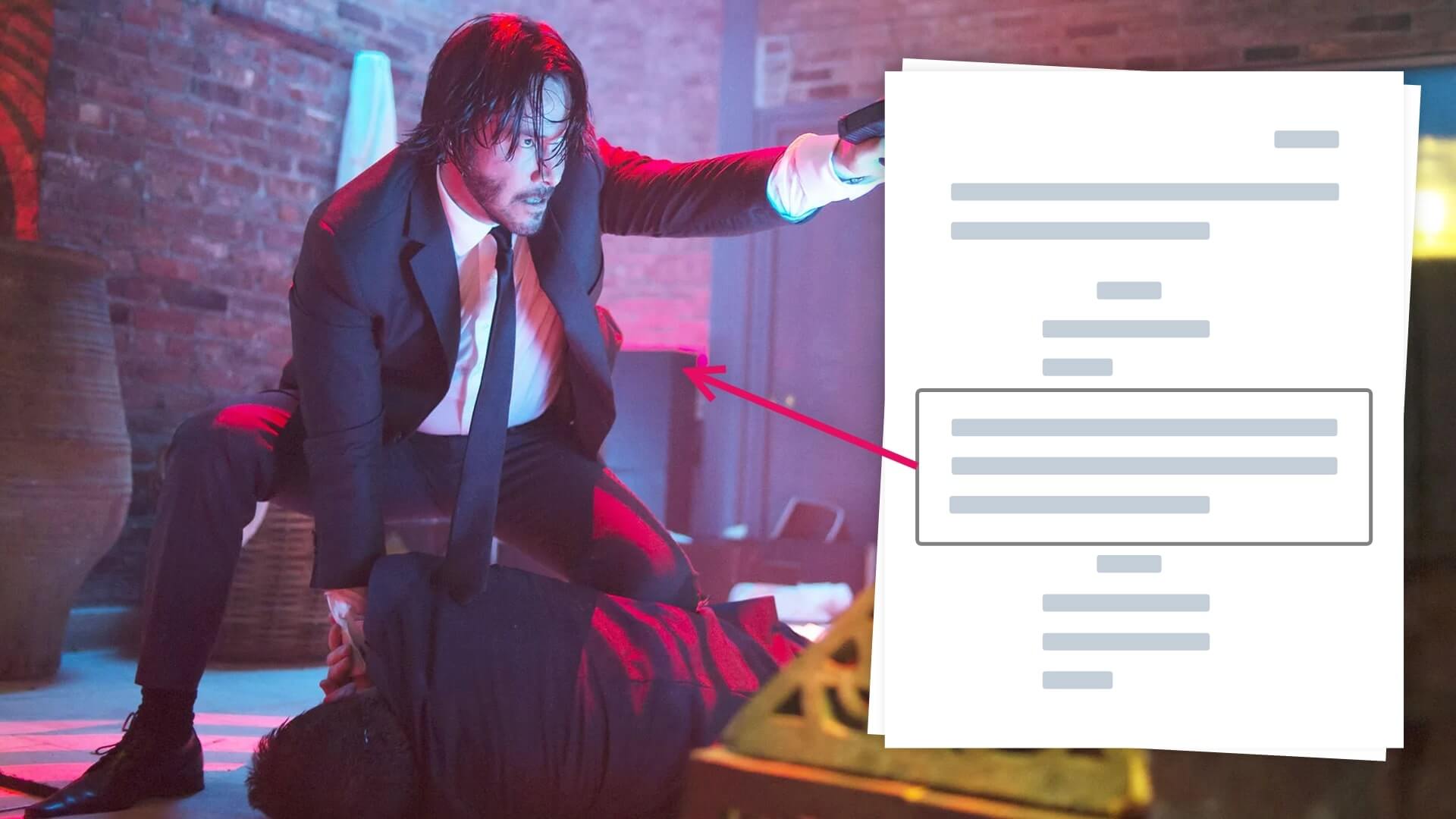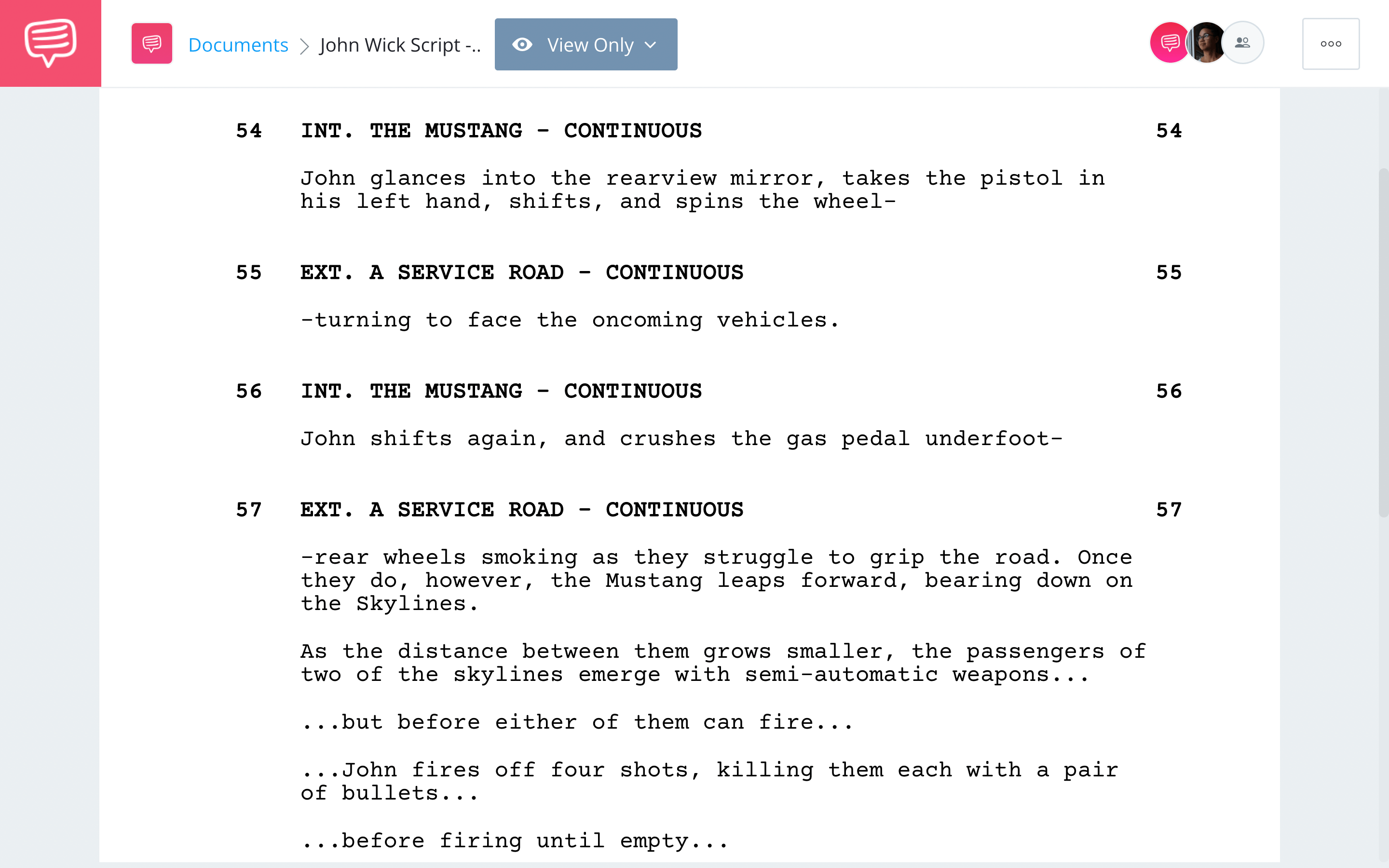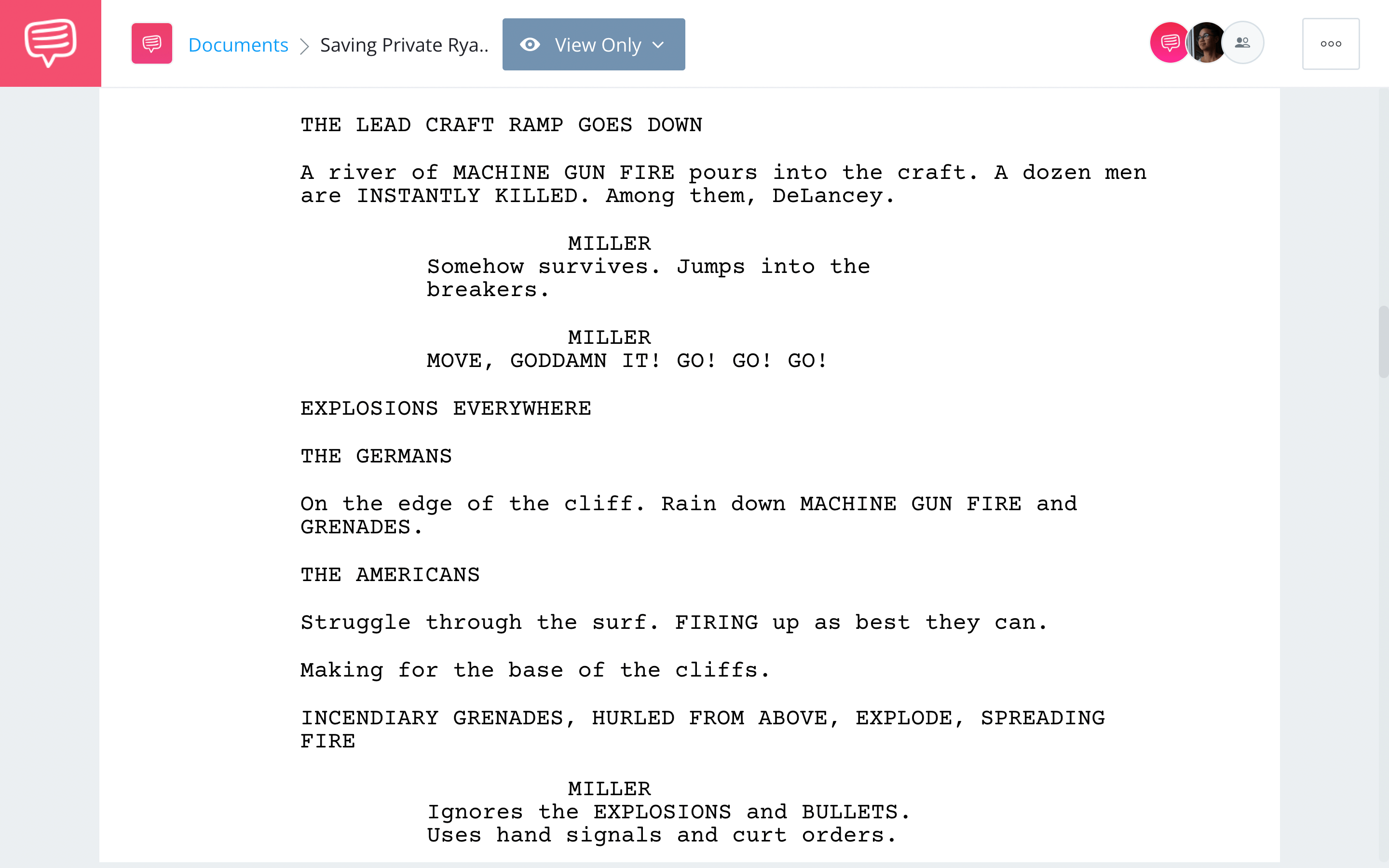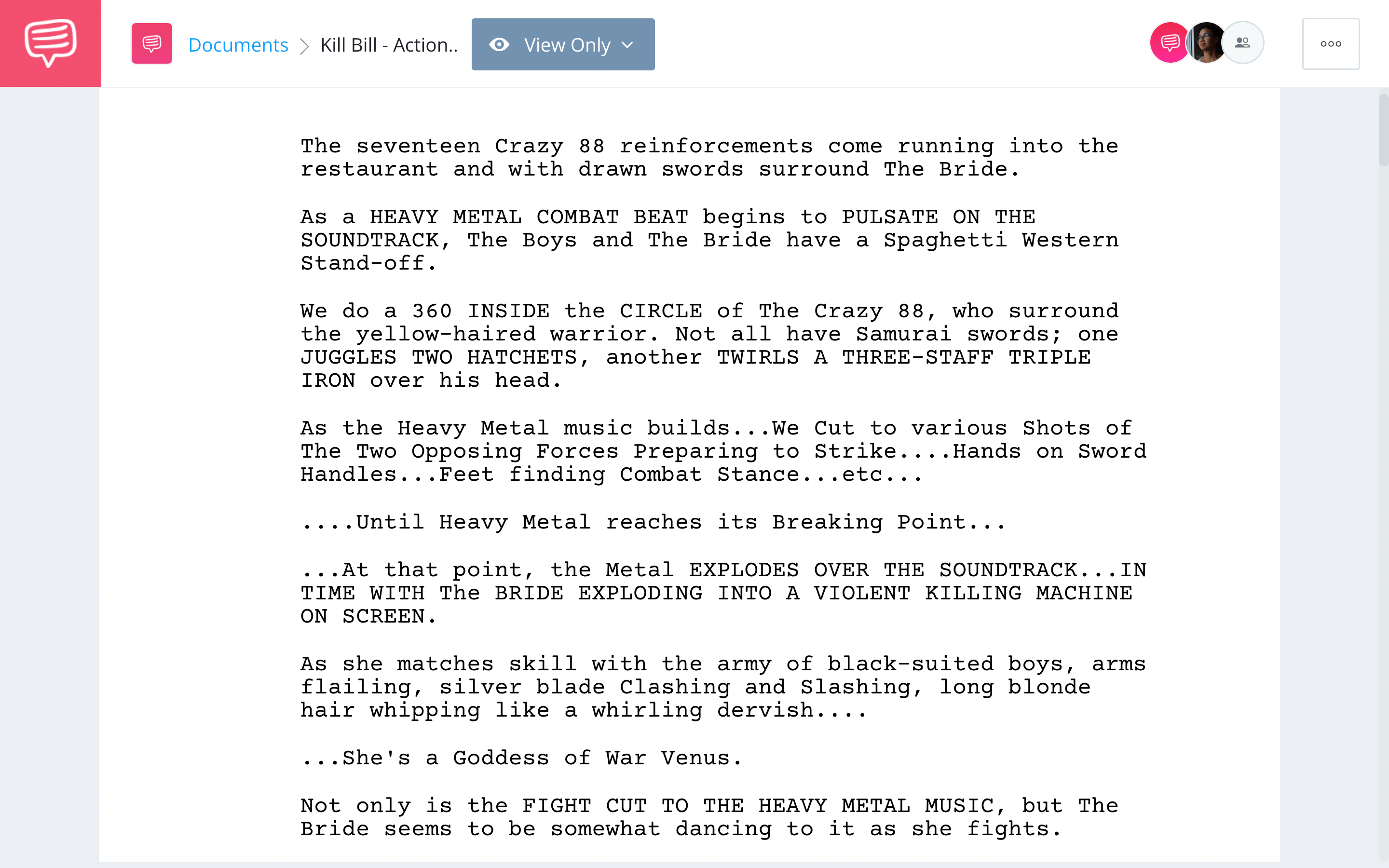How do you write an action scene in a screenplay? How specific and technical should you get? Or, is it better to leave the action description simplistic with the knowledge that a director, choreography, and stunt coordinator will be working out the details of the action? Different screenwriters answer these questions in different ways, and there is no ONE correct answer. Since action can be approached in a multitude of ways, let’s learn through examples and look at scripts that tackle action through three distinct methods.
Watch: How to Write a Good Fight Scene Like John Wick
How to Write an Action Scene in a Screenplay
Method 1: Get into the nitty-gritty
The biggest divide when it comes to writing fight scenes is over how granular the descriptions should get. You could turn to plenty of credible sources that would say to avoid writing out a blow-by-blow of the action at all costs. But, there are plenty of successful screenwriters who do get into the nitty gritty with their script’s action scenes.
One such screenwriter is Derek Kolstad, the writer of John Wick and Nobody. Kolstad’s John Wick script — originally titled Scorn — changed a great deal between writing and shooting. In the film, our first glimpse of John Wick in action is a shootout in his home…
John Wick — home invasion shootout • Describing a fight scene
Instead, in the screenplay, the first action sequence is a shootout at Aurelio’s garage, followed by an extended car chase action sequence. This action sequence never made it into the film, so let’s use it as an example and try to envision the scene as written in the way that a director would when first reading the script.
Click the image below to read the entire sequence using StudioBinder's screenwriting software.
A vehicular action scene from John Wick • Read the Sequence
We see that Kolstad goes into considerable detail in writing this vehicular action sequence. He writes out the shifting and gas-pedal pushing that other screenwriters might skip past in favor of the big-picture moments. So, how does he keep the scene engaging to read while delving into so much detail?
Kolstad uses many action lines in the script to describe the sequence but makes it quick-moving and readable by keeping the individual action lines short and snappy. Most action lines are contained within just a single sentence, and they never go beyond two sentences. He separates out the different action beats through a combination of ellipses and dashes that keep the pages from becoming intimidating walls of text. And, perhaps most importantly, the action is clean, precise, and easy to visualize as written.
For more on this subject, be sure to check out our how to write car chases post and our deeper dive into writing John Wick-esque fight scenes.
How to write fight scenes like John Wick • Subscribe on YouTube
For more examples of scripts that get into the nitty gritty, you can read the Die Hard screenplay or check out the scripts from Shane Black’s best movies.
Related Posts
Writing Fight Scenes Tips
Method 2: Keep it general
Keeping action scenes general is perhaps the more common approach to writing fight scenes in screenplays than delving into the nitty gritty. Some writers might pare back the descriptions all the way and simply write: “a fight happens.” This leaves all of the details for the production team to figure out.
Other writers might take a more bird’s eye view approach to describe the feel, intensity, and story/character beats of an action scene without writing out every punch or gunshot explicitly.
Let's watch the intense and chaotic D-Day landing scene that opens Saving Private Ryan. It is a massive and complex action sequence that lasts for more than 20 minutes. Watch the clip and then we'll look at how it was written.
Saving Private Ryan • Normandy beaches
Phew! That will always be one of the most visceral and effecting sequences. So, how was it tackled in one of the best war screenplays?
Saving Private Ryan • Read the Sequence
Screenwriter Robert Rodat opted for the overview method in writing the action during this complex sequence. Without getting into the gory details or the intricacies of the choreography, Rodat’s screenplay efficiently conveys the level of chaos and panic on the beaches.
The script contains just enough description to make the story of the scene clear, while Steven Spielberg and the rest of the production team would go on to flesh out the rest of the sequence.
We see that character details are afforded far more screenplay real estate than the details of the carnage. For example, Rodat spends five lines describing the tremble in Miller’s hand, while only using two all-caps words — “EXPLOSIONS EVERYWHERE” — to efficiently and generally establish the destructive environment the character inhabits.
For further reading, check out our list of the best WWII movies ever made and our breakdown of motion blur, which played an important role in the intensity of this D-Day landing sequence.
Related Posts
How to Write a Good Fight Scene
Method 3: Highlight key moments
The third method of writing action scenes is to split the difference between the two extremes. Doing this can give you the best of both worlds. Keep the broad strokes general, then delve into the details for the most important moments of the fight, chase, or shootout.
This is something Quentin Tarantino did when writing Kill Bill.
Kill Bill Volume 1 • Read the Crazy 88 fight
On this page, we see Tarantino keeping the action description general. Here, he offers a bird’s eye view of the fight and sums up the action sequence as a whole. But, on the following page, he dives into the nitty gritty.
Highlighting key moments • Read the Crazy 88 fight
Tarantino explicitly calls out “some SPECIFIC MOMENTS” before getting into more detail. Doing this allows him to write out key action beats in the massive Crazy 88 fight without the need to script out every single moment of the entire fight or to plan out the connective tissue between each moment.
With Tarantino bringing in the master Yuen Woo-Ping to oversee the action choreography, he can rest assured that the nitty gritty details and the flow of the sequence will be in safe hands. For a deeper dive into how Tarantino uses sound design in his fight scenes, check out the video below.
Exploring Tarantino’s sound design • Subscribe on YouTube
For more Tarantino goodness, check out our breakdown of how Tarantino writes dialogue, our exploration of Tarantino’s directing style, and our rundown of Tarantino’s best films.
Related Posts
Up Next
How to Write a Car Chase
Those were three different methods for writing action scenes in a screenplay. Up next, let’s zero in more specifically on how to write car chase sequences. We’ll take a look at the history of car chases in cinema, examine Baby Driver as a case study, then take a look at how George Miller storyboarded Mad Mad: Fury Road.




